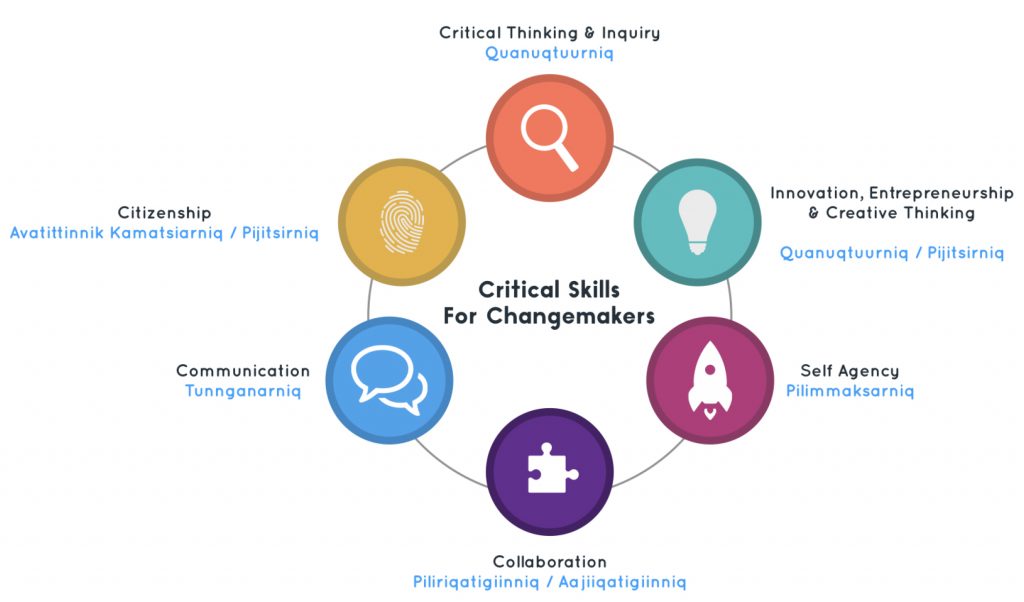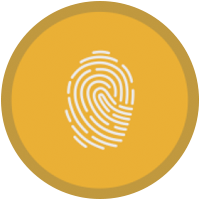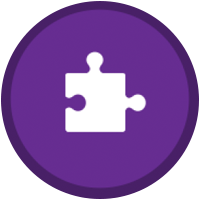Inspire Nunavik has outlined six critical skills that youth need to become agents of change in their communities. These skills are closely interlinked with the Inuit Qaujimajatuqangit (IQ): the Inuit societal values and principles outlined by the Government of Nunavut. Teachers should carefully read through and understand both the Inspire Nunavik’s Critical Skills and the IQ principles.
The critical skills identified by Inspire Nunavik have been designed with practical life skills in mind, and derived from the global research movement to develop 21st century, future and essential skills that are needed to be successful in the workplace and for entrepreneurship. . Each of these skills will allow students to build a subset of practical life skills that prepare them for future opportunities in school, work, higher education and in the community.
Below are the six critical skills students should build throughout the course and how they relate to IQ:
To be able to effectively connect with students in Nunavik, education needs to be grounded in Inuit culture and values. A set of core cultural beliefs and values about how to nurture powerful, sustainable and impactful communities and learning experiences should set the foundation for this program, how we teach, and how we learn. Learning in Northern communities, and arguably anywhere in the world, is most impactful when it follows shared community and cultural values. This approach allows learners to explore relevant issues imbedded in cultural thinking to guide learning.
The framework Inspire Nunavik uses is the Inuit Qaujimajatuqangit (IQ) principles developed by the Government of Nunavut.
Respecting others, relationships and caring for people.
Fostering good spirits by being open, welcoming and inclusive.
Serving and providing for family and/or community.
Pilimmaksarniq / Pijariuqsarniq
Development of skills through observation, mentoring, practice and effort.
Decision making through discussion and consensus.
Respect and care for the land, animals and the environment.
Piliriqatigiinniq / Ikajuqtigiinniq
Working together for a common cause.
Being innovative and resourceful.

Learn More…
Aajiiqatigiinniq: Become contributing members of their community & to participate actively in building the strength of Inuit in Nunavik
Pijitsirniq: To contribute to the common good through serving and leadership
Citizenship involves understanding and valuing diverse worldviews and perspectives in order to address cultural, political, ecological, social, and economic issues that are crucial to living in a contemporary, connected and sustainable world. Students acknowledge Indigenous, Francophone or other perspectives when taking action on local or global issues. They advocate for the dignity and well-being of individuals and communities. Students value equity and diversity, and believe in their capacity to make a difference. Students have an appreciation for the diversity of people, perspectives, and the ability to envision and work toward a better and more sustainable future for all.
Competencies
- Considering diverse perspectives when examining interactions between cultural, environmental, political or economic systems and communities
- Analyzing various ways in which decisions are made within cultural, environmental, political or economic systems
- Demonstrating responsible citizenship through actions that contribute to healthy and sustainable communities
- Evaluating the impact of decisions or actions on the dignity and well-being of individuals or communities
- Valuing equity and diversity and believing in the capacity to make a difference
Indicators of Success
How do we know that students are learning this skill?
Choose the appropriate indicators to add to your rubric. Students will…
- Contribute to society and the culture of the local, global, and digital community in a responsible, accountable, and ethical manner
- Engage in local and global initiatives to make a difference
- Interact safely and responsibly within a variety of communities
- Create a positive digital footprint
- Relate to the environment and is mindful of the importance of all living things
- Trust others and are trustworthy within the community
- Value, celebrate and tap into diversity among community members
- Work to understand and empathize with others
- Work to maintain an environment of safety, confidence, mutual esteem, and mutual support
- Enter into productive group work – helping others to achieve a common goal
- Take responsibility for a share of the work — keeping the interest of the community in mind
- Share themselves as teachers or mentors of others
- Contribute and solicit ideas, opinions and resources
- Take an active part in forming and supporting group decisions
- Express ideas, feelings, and hunches with diplomacy
Teacher Prompts
What a coach might say to encourage the development of this skill
- What are some of the unwritten rules that guide behavior in this classroom?
- Can we change the culture of this group? How?
- What differences among your small group members could you use to better do this work?
- What guidelines do we need to assure that we are all safe and respected here?
- How are we as a community?
- Do we affect one another’s learning?
- Pull yourself out and observe the interaction of your group. What do you see?
- How could you have expressed your idea in a way that would have been acceptable?
- Did you fully participate in making this decision with which you strongly disagree?
- What does your group think of that idea?
- What kinds of behaviors show respect?
- What do you know about your group members that you did not know before?
- What was the result of the way you resolved that conflict?
- Did you live up to your commitment here?
Tunnganarniq: The concept of fostering good spirit by being open, welcoming and inclusive
Communication involves sharing ideas through oral, written or non-verbal media. Students engage in formal and informal exchanges with others. Effective communication increasingly involves understanding both local and global perspectives, societal and cultural contexts, and adapting and changing using a variety of media appropriately, responsibly, safely, and with regard to one’s digital footprint. Students demonstrate respect, empathy and responsibility when communicating with others.
Competencies
- Expressing ideas or concepts using appropriate language, conventions or protocols
- Decoding and interpreting ideas or information through verbal or non-verbal formats
- Demonstrating respect and responsibility when communicating with others
- Clarifying the purpose or intention of a message in relation to audience context or culture
- Considering perspectives, emotions and experiences when seeking shared understandings
Indicators of Success
How do we know that students are learning this skill?
Choose the appropriate indicators to add to your Rubric. Students will…
- Communicate effectively in different contexts in oral and written form in French, Inuktitut and/or English
- Ask questions to acquire knowledge
- Communicate using a variety of media
- Select appropriate digital tools according to purpose
- Listen to understand all points of view
- Gain knowledge about a variety of languages
- Voice opinions and advocates for ideas
- Write with purpose and clarity
- Employ graphic interpretation and presentation
- Listen and observe with respect and understanding
- Express feelings clearly and honestly
- Read for understanding
- Communicate with honesty and authenticity
- Use an appropriate tone in oral and written communication
Teacher Prompts
What a Coach Might Say to Encourage the development of this skill
- How can we let others know about our decision/discoveries?
- Can you summarize what she said?
- What is your interpretation of that paragraph?
- Would it have been easier to understand if it was spoken rather than written?
- How would you outline the points made during this discussion or reading?
- Can you give an example of what you mean?
- Can you state that in a different way?
- What are some other ways you could use to get your idea across?
- Why is it important to listen?
- How do you know if someone is listening to you?
- What is a quality audience?
- How can the group keep communication going when you are apart?
- Do you prefer written or oral communication? Why?
- What do you need before you can communicate?
- What helps maintain communication?
- Are we communicating well here? When have we done it best?
- What does active versus passive communication look like?
Pilimmaksarniq: To be empowered and build capacity through knowledge and skills acquisition
Self Agency involves managing emotional, intellectual, physical, social and spiritual aspects of living. Students set learning, career or wellness goals and work toward them. They believe in one’s ability to learn (growth mindset). Students are reflective, resourceful and optimistic and they strive for personal excellence. They draw upon their strengths to develop interests, skills and talents and are aware and demonstrate agency in one’s process of learning, including perseverance, resilience, and self-regulation.
Competencies
- Identifying interests, values or skills to set learning, life or career goals
- Exploring, selecting or adapting strategies and resources that support personal growth in life,school or career pathways
- Making choices or taking action to promote the safety and well-being of self or others
- Building healthy relationships to support growth and well-being of self and others
- Demonstrating optimism, exibility or resilience when adapting to new situations and transitions
Indicators of Success
How do we know that students are learning this skill?
Choose the appropriate indicators to add to your Rubric. Students will…
- View problems as challenges or opportunities for learning and personal growth rather than as obstacles (growth mindset)
- Persevere and overcome challenges to reach a goal
- Self-regulate in order to become a lifelong learner
- Reflect on experiences in order to make positive changes and to enhance learning
- Understand self and others
- Has a positive outlook
- Takes initiative
- Adapt to change and shows resilience to adversity
- Take responsibility for the processes and outcomes of learning
- Honestly account for their own actions
- Engage in decision-making processes at the individual, community and societal levels
- See the importance of risk-taking and take appropriate risks
- Value advice
- Take responsibility for setting a course for themselves and for adjusting that course
- Assess their own needs and translate them into obtainable goals
- Take action from a work ethic that is defined as going well beyond what is required
Teacher Prompts
What a Coach Might Say to Encourage the development of this skill
- If you had to accomplish this by yourself, how would you do it?
- What skills do you have that are well suited to this task?
- What could better motivate you?
- Whose responsibility is it to follow through on this?
- Why is this work important to you?
- How could you make this into something of which you can feel truly proud?
- What risks might you be taking if you follow through with this idea?
- Could you describe your individual contribution to this work?
- Excellent suggestion. How will you make it happen?
- Is it important enough to you to take a stand?
- Are you satisfied with the results? Are you willing to go further with this?
- Is this your decision? Should others be involved?
- If you had to accomplish this by yourself, how would you do it?
- Do you need some information before you begin?
- What are the possible places you could find information about that?
- What can you use to help you here?
- What could better motivate you to do this independent research?
- What have you done like this on your own?
- How can your work be shared with the group?
- What are your goals here?
Qanuqtuurunnarniq: To be resourceful and seek solutions through creativity, adaptability, and flexibility
Pijitsirniq: To contribute to the common good through serving and leadership
Innovation, Entrepreneurship and Creative Thinking involves generating and applying ideas to create something of value. Students recognize opportunities to apply ideas in new ways. They are open to and play with ideas, take risks and adapt to changing conditions. Students demonstrate optimism, initiative and ingenuity. Entrepreneurial mindsets and skills involve a focus on building and scaling an idea sustainably.
Competencies
- Recognizing opportunities and imagining possibilities to apply ideas in new ways
- Exploring or playing with ideas, materials or processes to create something new
- Evaluating and adapting ideas, materials or processes in response to feedback or emerging conditions
- Demonstrating initiative, resourcefulness and perseverance when transforming ideas into actions, products or services
Indicators of Success
How do we know that students are learning this skill?
Choose the appropriate indicators to add to your Rubric. Students will…
- Contribute solutions to complex problems
- Enhance a concept, idea, or product
- Take risks in thinking and creating
- Make discoveries through inquiry and research
- Pursue new ideas to meet a need of a community
- Lead and motivate with an ethical entrepreneurial spirit
- Recognize conformist, conventional, in-the-box thinking and seeking
- Find alternatives
- Synthesize old ideas into unique or fresh approaches
- Integrate seemingly unrelated ideas
- Dream about the possible
Teacher Prompts
What a Coach Might Say to Encourage the development of this skill
- Is there a new way of solving the same problem?
- What is the other side of this question?
- Given these conditions, what are some designs that might be applicable?
- Can you think of a different approach?
- Why do you think that?
- How do you suppose he would react to that idea?
- What would have happened if you had done what you considered doing?
- How would you be able to recognize that in another setting?
- How would you develop that at home? in another country?
- How many solutions/ideas can we brainstorm?
- What is a wild, unconventional, but workable approach to this problem?
- What was an idea you were afraid to try? Why?
- Did anything pop into your head that seemed totally unrelated?
- Which of these ideas could be combined to achieve a solution?
- What is the most creative thing you have done so far? How did it happen?
- If you could come up with a solution with no limiting factors, what would that be?
- What if you looked at this from a totally different perspective?
Avatittinnik Kamatsiarniq: To show environmental stewardship
Aajiiqatigiinniq: To cooperate, develop shared understanding to arrive at decisions through consensus
Critical thinking and Inquiry involve addressing complex issues and problems by acquiring, processing, analysing and interpreting information to make informed judgments, decisions and actions. This involves using reasoning and criteria to conceptualize, evaluate and synthesize ideas. They challenge assumptions behind thoughts, beliefs or actions. Students value honesty, fairness and open-mindedness. The capacity to engage in cognitive processes to understand and resolve problems includes the willingness to achieve one’s potential as a constructive and reflective citizen.
Competencies
- Questioning and analyzing evidence, assertions or assumptions
- Applying reasoned approaches or relevant criteria to conceptualize, analyze or make judgements
- Reflecting upon and evaluating reasoning behind thoughts, beliefs or actions
- Synthesizing thoughts and information to discover or extend understandings
- Demonstrating intellectual integrity, fairness and open-mindedness
Indicators of Success
How do we know that students are learning this skill?
Choose the appropriate indicators to add to your Rubric. Students will…
- Acquire, process, interpret, and analyse information to make informed decisions
- Engage in an inquiry process to solve problems
- Make connections and transfer learning from one situation to another
- Inquire into the world around them
- Asks questions
- Analyze information and events objectively and developing verification procedures
- Discern between cause and effect
- Distinguish fact and opinion, influence and manipulation
- Synthesize information and ideas
- Seek to be well-informed and taking the total situation into account
- Judge the credibility of a source, using credible sources, and accurately
- Is open minded
- Identify assumptions
Teacher Prompts
What a Coach Might Say to Encourage the development of this skill
- How else might we go about this work?
- What other ways might you demonstrate your understanding?
- What do you want to learn from this work?
- How could we do this better?
- Even if it doesn’t work out, can you try doing this a different way?
- What is the most unique aspect of this product or process?
- What would happen if…?
- Can you reach this outcome in other ways?
- If there were no limitations of time or resources, how would you go about…?
- Do you feel that other people or cultures would see/understand this differently?
- What does this information/data tell you about this subject?
- What are the positive/negative aspects of this situation/idea?
- Would that solution work in this situation? Why? Why not?
- Can you think of a similar situation?
- What are the underlying assumptions to that argument?
- What do you think caused this?
- Into what categories could you break this down?
- What different sources could you pool together to get an answer?
- What are all the options we can look at?
- Have you adjusted your plans or thinking along the way?
- What is most confusing about this?
- What parts of our information are based on facts? Opinions? Your opinion?
Aajiiqatigiinniq: To cooperate, develop shared understanding to arrive at decisions through consensus
Piliriqatigiinniq: To develop a collaborative relationship and work together for the common good
Collaboration involves the interplay of the cognitive, interpersonal, and intrapersonal competencies necessary to participate effectively and ethically in teams to achieve a common goal. Students participate, exchange ideas and share responsibilities. Skills are applied across diverse situations, roles, groups, and perspectives in order to co-construct knowledge, meaning, and content, and learn from, and with, others in physical and virtual environments. Students respect alternate views and nurture positive relationships. Students are adaptable, willing to compromise and value the contributions of others.
Competencies
- Sharing responsibilities and supporting others to achieve a common goal.
- Demonstrating sensitivity to diverse cultures, audiences or contexts when working with others.
- Exhibiting reciprocity and trust when sharing ideas or roles
- Valuing flexibility, compromise and the contributions of others to nurture positive working relationships
Indicators of Success
How do we know that students are learning this skill?
Choose the appropriate indicators to add to your Rubric. Students will…
- Participate in teams; establish positive relationships
- Learn from, and contribute to, the learning of others
- Co-construct knowledge, meaning, and content
- Assume various roles on the team
- Manage conflict
- Network with a variety of communities/groups
- Respect a diversity of perspectives
- Value collaboration
- See conflict of issues and ideas as an essential aspect of collaboration
- Contribute to and invest in a group vision
- Further themselves and others in pursuit of common goals
- Value, build on and maximize ideas, abilities and perspectives of others
- Keep personal agendas in perspective
- Resolve conflict by seeking new or common ground
Teacher Prompts
What a Coach Might Say to Encourage the development of this skill
- How can we put our heads together to begin work?
- How will decisions be made within the group?
- What are some ways of structuring the group for this work?
- Can anyone in your group answer your question?
- How can we hear from everyone in the group?
- If you had a problem person in your group, how would you deal with him/her?
- How are we as a group?
- What have we produced as a group? How could we do it better?
- What skills are there in your group from which you can draw?
- Have you been clear in your thoughts, actions, and feelings with your group?







